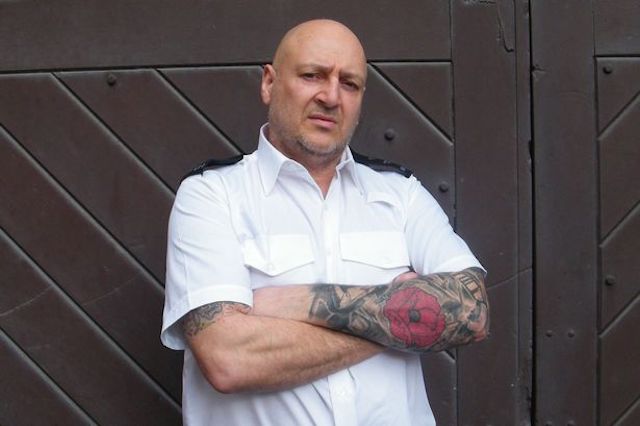Prison Guards Share their Experiences with ‘One Percenter’ Inmates
Credit to Author: Nick Chester| Date: Tue, 12 Mar 2019 13:27:49 +0000
Every prison in Britain contains a small minority of inmates who are deemed so disruptive that they rarely enter the mainstream population, instead serving most of their sentences in solitary confinement. They’re known as “one-percenters”, and range from inmates who repeatedly smash up any wing they’re placed on, to those hell-bent on serious violence. Charles Bronson is perhaps the best known example, starting fights throughout his imprisonment and spending 24 of his 28 years inside in solitary confinement.
I wanted to find out what it’s like to deal with these ultra-aggressive prisoners, so called up Neil Samworth and Tony Levy, who spent 11 years and 26 years in the prison service respectively, and serving prison guard Dana.
NEIL SAMWORTH

One of the most memorable “one-percenter” inmates I came across was a lad I’ll call “AF”. He’d been serving a short sentence but had attempted to escape, resulting in a substantial amount of time being added to his stint. He’d got his step-dad to turn up with a firearm while he was on a hospital visit and threaten the escorting officers so that he could do a runner.
After being caught in Scotland, AF eventually ended up being taken to Strangeways, the prison I worked at. The officers at his previous jail had placed him in a special restraint known as a body belt to transport him, but he’d somehow managed to break free from it. This was no easy task, and provided an early indication of the type of prisoner he was.
AF was housed in the healthcare unit because he was a prolific self-harmer and needed constant observation. He was polite as anything until the officer in charge of keeping an eye on him turned the light on in his cell, which he didn’t like. When prisoners are placed under observation because they’re at risk of self-harm, the light isn’t typically kept on all night because it stops them from sleeping. “Can you get the other officer to turn it off?” AF asked me. I tried to get my colleague to do as he said, telling her it’d be better if she just put it on every now and then to check on him, but she said, “I’m doing the job, not you. I’m leaving it on.”
AF wasn’t having it, and ripped the light fitting out. The light had been embedded in the wall to make it difficult to destroy, so this was no mean feat. It had been connected to the wiring for the entire landing, so the other cells were also plunged into darkness. AF then slid a piece of metal and some wires from the fitting underneath the door so that we could admire his handiwork, said goodnight and got into bed.
This was the first of many incidents. He was an influential prisoner, and soon taught other inmates how to rip out the light fittings. He’d also starve himself and self-harm when officers did something he didn’t like. He’d dig his fingernails into his flesh so hard that blood sprayed out so that he could flood the cell with claret and wreck the place. There would sometimes be so much of it on the floor that a skin would form on top of it before it dried.
The prison governor eventually told AF that he was going to be placed in the segregation unit. He threatened to disrupt the entire prison if he was moved, but was taken there anyway. He was put in something called a “special cell”, which is an empty room intended for people who are particularly violent or prone to self-harm. The idea is that there’s nothing in there they can use to harm either themselves or anybody else.
Within minutes of the door closing, AF had pulled a panel out of the wall, ripped an electrical conduit out and smashed it through the observation panel. He then dug his nails into his arm and flooded the cell with claret. He eventually passed out from blood loss and had to be taken to hospital. He continued to be so disruptive that he remained segregated for his entire sentence, which is the norm for one-percenters. They usually remain in smaller units like the segregation block, where they can be better managed.
TONY LEVY

When I was working at HMP Woodhill in the CRC Unit, a prisoner who had killed three inmates while serving a life sentence for murder was sent there. He’d committed a murder while at Broadmoor Psychiatric Prison, which meant they hadn’t allowed him to remain under their supervision and had returned him to the non-psychiatric-prison population. All of his victims had suffered incredible acts of torture before being killed. The CRC Unit is a special wing designed for extremely disruptive prisoners who can’t be allowed into the mainstream prison population. It was decided that this inmate would be placed in permanent segregation and moved from one prison to another every 28 days.
I found him to be a highly intelligent person who, due to his upbringing and the sexual experiences he’d suffered in his formative years, had become a highly dangerous individual. He was extremely frightening, and probably the only prisoner I’ve ever been a little scared of. In 1983, he was deemed too dangerous for a normal cell. Prison authorities built a two-cell unit in the basement of Wakefield Prison, dubbed the “glass cage”, to house him in for the duration of his confinement. It was noted for its resemblance to Hannibal Lecter’s cell in The Silence of the Lambs.
Dana
We had an inmate in the jail a few months back who kept getting sent back to the segregation unit almost as soon as he’d been released back into general population. He was totally unmanageable, and enjoyed the notoriety his antics gave him within the prison. His main gripe was that he thought inmates should be allowed to vape in jail, in spite of the fact that smoking is banned. I guess he thought that because it doesn’t involve tobacco, it isn’t covered by the ban.
He was always kicking off and smearing shit all over his cell in protest. He would also threaten to slash his wrists if we didn’t let him vape, which we had to take seriously because he had a history of self-harm. We obviously didn’t give in and allow him to vape, but had to put the necessary precautions in place just in case he ever went through with his threats. He was relatively small and unassuming, so it was surprising that he managed to cause so much chaos.
This article originally appeared on VICE UK.